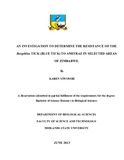Please use this identifier to cite or link to this item:
https://cris.library.msu.ac.zw//handle/11408/512Full metadata record
| DC Field | Value | Language |
|---|---|---|
| dc.contributor.author | Yiwombe, Karen | - |
| dc.date.accessioned | 2014-12-16T11:55:39Z | - |
| dc.date.available | 2014-12-16T11:55:39Z | - |
| dc.date.issued | 2013 | - |
| dc.identifier.uri | http://hdl.handle.net/11408/512 | - |
| dc.description.abstract | The purpose of this study was to determine if the Boophilus species spectrum of ticks infesting cattle owned by resource limited farmers in the state owned communal land areas of Zimbabwe, are resistant to Amitraz. The study was also aimed at finding a concentration of the acaricide that the tick species are susceptible to, and can give at least 99.9% mortality. Five districts were selected from the Matabeleland South province and five farms were randomly selected from each district. The study was carried out from December 2012 to February 2013. The most numerous ticks collected were the Rh. B. microplus and Rh. B. decoloratus and these were the ticks of interest as they cause the major Tick Borne Diseases (TBDs) that have a great impact in the economy. Fully engorged female ticks were collected at random from the cattle in all the selected farms. Sample collection was repeated after every month within the duration of the study. More than 100 fully engorged female ticks were collected from Insiza, Mzingwane, Mberengwa, Nkayi and Tsholotsho and these were identified, cultured and larval ticks were produced in the laboratory. The laboratory work was carried out at Central Veterinary Laboratories in Harare, following their standard operating procedures. Using the Larval packet test, pieces of Whatmann 541 filter papers were impregnated with oil solution containing the acaricide, Amitraz. The papers were formed into packets where tick larvae were put and the response was determined after 24 hours. The packets were opened and the tick larvae examined under a lude light. All moving larvae were counted and removed by sucking them up a vacuum pump. Only those larvae capable of walking were considered alive. The remaining dead ticks were counted and results recorded. The data obtained were expressed as percentage mortality at each concentration level. A two way ANOVA was conducted to examine the effect of concentration and species on tick mortality. The dependant variable (mortality) was normally distributed for the groups formed by the combination levels of concentration and species as assessed by the Shapiro-Wilk test. There was homogeneity of variance as assessed by Levine’s test for equality of error variances. Data was organized and represented in the form of descriptive tables, histogram and line graphs to assist in the analysis of data. Three districts showed about 99.5% elimination of the ticks using Amitraz whereas the other two showed 79% and 47%. The results implied that there is no acaricide resistance in the selected districts and that tick control failure is due to factors other than resistance. | en_US |
| dc.language.iso | en | en_US |
| dc.publisher | Midlands State University | en_US |
| dc.subject | Boophilus species spectrum | en_US |
| dc.title | An investigation to determine the resistance of the boophilus tick (blue tick) to amitraz in selected areas of Zimbabwe | en_US |
| item.languageiso639-1 | en | - |
| item.grantfulltext | open | - |
| item.fulltext | With Fulltext | - |
| Appears in Collections: | Bsc Biological Sciences Honours Degree | |
Files in This Item:
| File | Description | Size | Format | |
|---|---|---|---|---|
| karen_dissertation-final.pdf | 619.86 kB | Adobe PDF |  View/Open |
Page view(s)
216
checked on Dec 24, 2025
Download(s)
180
checked on Dec 24, 2025
Google ScholarTM
Check
Items in MSUIR are protected by copyright, with all rights reserved, unless otherwise indicated.



